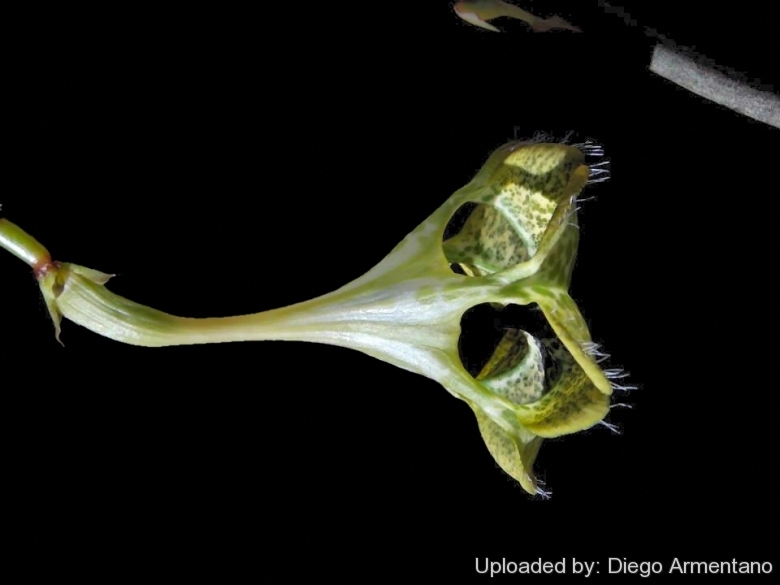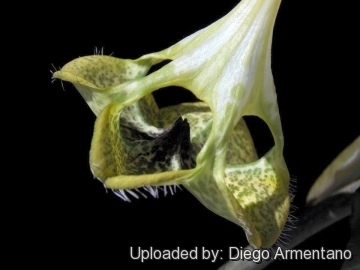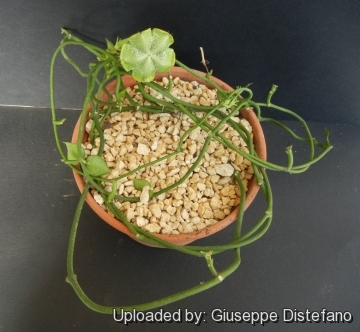
Ceropegia sandersonii Photo by: Diego Armentano
The flowers of Ceropegia sandersonii emit a scent that contains substances similar to the pheromone released by bees in mortal danger as a warning signal for companions. This way some carnivorous flies, the only ones that pollinate the plant, are attracted to the flower hoping to feast on the bee that is not there. Once the fly is laying on the flower of C. sandersonii, it is temporarily trapped by some complex capture structures of which the flower is equipped.
Origin and Habitat: Ceropegia sandersoni is native to southeastern and southern Africa. South Africa (Transvaal Natal), Swaziland and the coastal regions of Mozambique.
Synonyms:
See all synonyms of Ceropegia sandersonii
back
Accepted name in llifle Database:Ceropegia sandersonii Decne. ex Hook.Bot. Mag. t. 5792 1869Synonymy: 3
back
Common Names include:
ENGLISH: Parachute Plant, Umbrella Plant, Parachute flower, Sanderson's Ceropegia, Fountain flower, Umbrella flower, Giant ceropegia, Windowed flowers
AFRIKAANS (Afrikaans): Sambreelblom
GERMAN (Deutsch): Kletternde Leuchterblume
Description: Ceropegia sandersoniiSN|26496]]SN|26496]] (a.k.a. "sandersoni" or "sandersoniae") is one of the most peculiar kinds of Ceropegia with mottled, cornucopia-like green flowers, about 7 cm long, the petals of which are united by their tips forming a kind of windowed canopy shaped and fringed like a parasol over the stamens and pistil, the whole wonderously mottled in green and yellow. It has probably the largest flower in the genus and is justly prized for its striking blooms. The heart shaped leaves and green flowers help identify this plant.
Habit: It is a prostrate or erect trailing or climbing plant (liane), twining on the general vegetation, with a habit of the vanilla orchid, sometimes reaching a height of 4 m. In cultivation it requires a trellis or other support on which to twine.
Roots: The plant has a cluster of fleshy narrowly fusiform tuberous root.
Stem: Fleshy, nearly hairless, perennial, mostly leafless, twining to 2 (or more) metres long, about 5 mm thick.
Leaves: Simple, fleshy, 2-5 cm long 1,2-2,5 cm broad, borne in pairs along the slightly warty stem, ovate to heart-shaped. grass-green on new growth, with a stalk to 6 mm long.
Flowers: 2-4 on stalks to 1 cm long, pallid green with darker vertical stripes and the top of the canopy spotted green or purplish-maroon. Tube is cream striped. Corolla 4-7(-8) cm tall and 2,5-5 cm across the top with a scarcely swollen base and campanulate expansion of the top where the 5 lobes converge to form an umbrella-like canopy fringed with silky white to purple hairs. The openings between the petals are also referred to as windows, hence the name windowed flowers. The flower itself serves as a biological myiophilous (fly-pollinated) pitfall-trap, that traps flies when they descent into the corolla tube. Small hairs that are pointed downwards prevent the insect from escaping. Once trapped, the victim is thoroughly pollinated and only released when the flower is left off and the hairs weaken.
Blooming season: Summer and autumn.
Bibliography: Major references and further lectures
1) A. B. Graf “Tropica: Color Cyclopedia of Exotic Plants and Trees from the Tropics and Subtropics” Roehrs, 1978
2) Robert Allen Dyer “Ceropegia, Brachystelma and Riocreuxia in Southern Africa” A.A. Balkema, 01/gen/1983
3) James Cullen, Sabina G. Knees, H. Suzanne Cubey “The European Garden Flora Flowering Plants: A Manual for the Identification of Plants Cultivated in Europe, Both Out-of-Doors and Under Glass” Cambridge University Press, 11/Aug/2011
4) Hermann Jacobsen “A handbook of succulent plants: descriptions, synonyms, and cultural details for succulents other than Cactaceae", Volume 1 Blandford Press, 1960
5) Focke Albers, Ulrich Meve “Illustrated Handbook of Succulent Plants: Asclepiadaceae” Volume 5 Springer, 2002
6) Sajeva, Maurizio and Costanzo, Mariangela. "Succulents: The Illustrated Dictionary" Portland, Ore.: Timber Press, 1994.
7) Barbara Segall “Botanica: the illustrated A-Z of over 10,000 garden plants and how to cultivate them” Mynah, 1997
8) Gideon Smith, Neil R. Crouch “Guide to Succulents of Southern Africa” Struik Nature, 01/nov/2009
9) Pooley, E. “A Field Guide to Wild Flowers Kwazulu-Natal and the Eastern Region.” Natal Flora Publications Trust, Durban. 1998
10) Focko Weberling (Author), R. J. Pankhurst (Translator). “Morphology of Flowers and Inflorescences.” Cambridge University Press; New edition edition. 1992
11) Le Scienze - edizione italiana di Scientific American “Il fiore e il profumo dell'ape in pericolo” 07 October 2016 <http://www.lescienze.it/news/2016/10/07/news/impollinazione_ceropegia_mosche_allarme_ape-3265612/>
 Ceropegia sandersonii Photo by: Giuseppe Distefano
Ceropegia sandersonii Photo by: Giuseppe Distefano Ceropegia sandersonii Photo by: Diego Armentano
Ceropegia sandersonii Photo by: Diego Armentano Ceropegia sandersonii Photo by: Giuseppe Distefano
Ceropegia sandersonii Photo by: Giuseppe Distefano Ceropegia sandersonii Photo by: Giuseppe Distefano
Ceropegia sandersonii Photo by: Giuseppe DistefanoCultivation and Propagation: Ceropegia sandersoniiSN|26496]]SN|26496]] grows best in tropical or subtropical climates. It is used an ornamental vine and makes also a good room plant.
Exposure: It need partial shade or filtered sun. Shade is sometimes provided in hot climates.
Substratum: The plants like a rich, porous, well-drained soil mix, with extra leaf mould added but aren't usually too picky as to soil type.
Watering: During the growing season (March-August), the plants are watered on a regular basis, making sure that they never dry out completely with an occasional spray over the foliage. In late August, water is restricted to about once a week until January. Night temperatures at this time should be about 10° C. In January or February, watering is stopped for a period of 4 weeks. In March, regular watering is resumed.
Fertilization: They are fertilized on a monthly basis with a balanced fertilizer during active growing phase.
Hardiness: Will tolerate temperatures to 45° C, but prolonged cold will damage or kill the plant.
Propagation: Ceropegia sandersoniiSN|26496]]SN|26496]] is propagated by stem cutting or (rarely) by seed in the spring. Seed should be sown in well-drained compost and should germinate in 14 to 28 days at 18 to 21° C.














